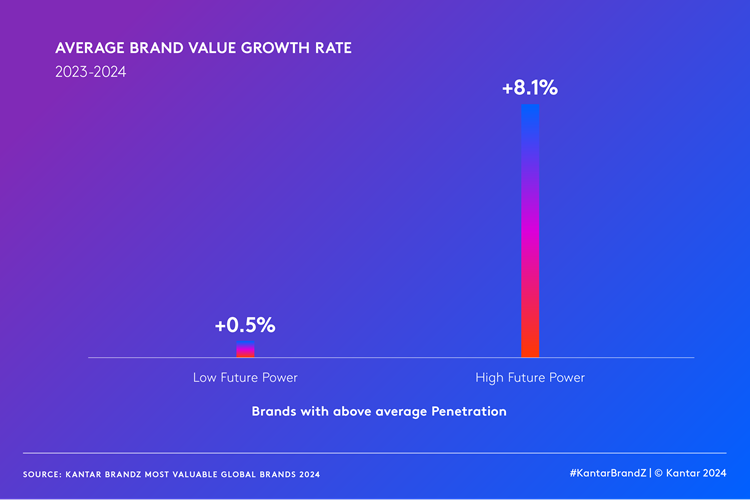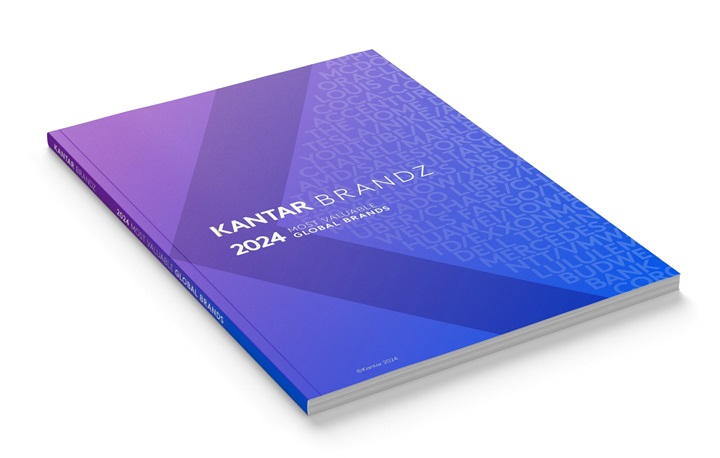Brand value and brand valuation are essential for marketers, as they measure the impact of brand building and provide guidance for future growth. Kantar BrandZ is the definitive guide to brand value, as it combines financial data, consumer research, and proven frameworks to assess how brands contribute to business performance. Brand value is driven by three key factors: Meaningful Difference, which predisposes more people to buy and pay more; Presence, which optimises brand visibility and salience; and Future Power, which enables brands to expand into new spaces. Brands with high value are more resilient, profitable, and sustainable, and can leverage opportunities and challenges.
In a return to growth following the challenges of recent years, the total value of the Kantar BrandZ Global Top 100 Most Valuable Brands has risen by 20% in 2024. If there’s one thing the world’s strongest brands have in common, it’s an unwillingness to rest on their laurels. Today’s top brands – and brand marketing teams – are always looking to accelerate growth. But how? I’ve summarised my thoughts into these 10 key takeaways:
1. Build brand equity to accelerate growth
Brands with strong equity outperform the market and recover faster from crises. Brand value represents 32% of company value for the Top 100 Most Valuable Global Brands, an increase of 30% versus 2023. To build equity, brands need to be Meaningful, Different and Salient in consumers' minds. Kantar's Blueprint for Brand Growth provides a holistic approach to activate these drivers and optimise brand investment.
2. Leverage tech brands' expertise and innovation
Tech brands dominate the Global Top 100, contributing $1.2 trillion of the Top 100's $1.4 trillion growth. Tech brands are also the fastest-growing category, rising 45% year on year. Marketers can learn from tech brands' ability to deliver superior customer experience, breakthrough innovation, and scalable platforms or partnership ecosystems. ServiceNow “puts AI to work for people today – enabling people to be more productive, more responsive and more innovative” and has climbed into the Kantar BrandZ rankings for the first time in 2024.

3. Embrace the opportunities of generative AI
Generative AI can be valuable for brands, as it can create new content, products, and experiences. There will be opportunities to harness the power of generative AI to enhance creativity, personalisation and efficiency. However, brands also need to avoid the pitfalls of greenwashing, ethical issues, and consumer mistrust. NVIDIA is the fastest riser in the Top 100 in 2024, increasing its brand value by 178%, by aligning itself closely to the needs of generative AI computing – the hardware, the operating environment and the software.
4. Adapt to the macroeconomy of volatility, variability, and viability
The global economy is facing unprecedented challenges, such as uncertainty, trade tensions, inflation, and climate change. Companies need to operate flexibly, invest in durable assets – like brands – and focus on demand fundamentals. Brands also need to communicate clearly, authentically and inclusively to inspire trust and loyalty. The good news is that volatility is also a creator of new opportunities, exemplified by the fact that the fastest risers and new entrants in Kantar BrandZ’s 2024 rankings come from all parts of the world, like Mercado Pago in Argentina, Pull&Bear in Spain and Flipkart in India.
5. Understand and address the needs of struggling consumers
Many consumers are facing financial difficulties and spending constraints due to the ongoing effects of the global pandemic and inflation. Brands need to empathise with their challenges and offer solutions that add value. To reach struggling consumers, try to make products more accessible, affordable, and if possible, sustainable. Building predisposition to support higher price points is achievable, and Kantar BrandZ data shows that consumers will choose a higher-priced brand if the brand successfully justifies its price. Brands that create ‘excess’ Pricing Power attain three times the penetration of brands with low or average Pricing Power among struggling consumers.
6. Identify and stretch into new spaces
Growth can come from anywhere. Brands can accelerate growth by finding new spaces to expand into, such as new markets, segments, or categories. Smaller brands have opportunities to find new demand spaces within their category and take share from dominant competitors. Larger brands need to have sufficient momentum and Future Power to extend into new or adjacent categories. They can do this by leveraging their core strengths and capabilities and innovating with relevance and differentiation. Chinese baijiu brand Moutai has successfully extended from its alcohol core into luxury ice cream and chocolate.

7. Focus on maintaining a Meaningful Difference
The historic trends in the Kantar BrandZ database show that it is increasingly hard to maintain an advantage on Meaningful Difference. Only 1 in 25 brands has a relative strength on both dimensions. But these are essential qualities to support penetration and market share. One route to success from brands is to revive and promote their classic products to reignite hype and drive sales. For example, Adidas successfully leaned on revivals of classic shoe models like the Samba, Gazelle, and Spezial.
8. Be More Present in consumers’ lives
Optimise presence in the moments and places where consumers are engaging with the category. Brands should be looking to use a mix of media and channels to increase visibility and salience during the consumer decision journey, up to and including the point of purchase. It’s helpful to inform media planning and execution with data and insights specific to the brand rather than relying on generic media rules. Getting this right is important: the brands that grew more in the Kantar BrandZ 2024 rankings were better on average at converting Demand Power in the minds of consumers into sales – winning an extra +2 percentage point of volume share.
9. Create Meaningful and authentic connections
Aligning values and messages to the audience. European brands, like French luxury style brand Hermès, have outperformed others this year by leveraging heritage and quality to differentiate themselves. Authentic brands follow the “3i’s” principle to build trust: integrity, identification and inclusion. Brands that improved on both Meaningful and Different metrics this year grew +19% ahead of expectations.

10. Go Local
Global instability offers international brands the chance to connect better by localising. Brands can speak to local or national identity through product variants, innovation or in brand communications. Physical locations in proximity to consumers helps brands be more present and relevant. Chase Bank in the USA has outgrown all competitors on brand value this year by opening new branches targeting states where they had less presence and communities that were under-served by other banks.
The Kantar BrandZ Most Valuable Global Brands 2024 report, including the Global Top 100, 13 category rankings and analysis on the key factors driving growth for the world’s most valuable brands are now available here.
For a quick read on a brand’s performance compared to competitors in a specific category, Kantar’s free interactive tool, BrandSnapshot powered by BrandZ, provides intelligence on 14,000 brands. Find out more here.
In a return to growth following the challenges of recent years, the total value of the Kantar BrandZ Global Top 100 Most Valuable Brands has risen by 20% in 2024. If there’s one thing the world’s strongest brands have in common, it’s an unwillingness to rest on their laurels. Today’s top brands – and brand marketing teams – are always looking to accelerate growth. But how? I’ve summarised my thoughts into these 10 key takeaways:
1. Build brand equity to accelerate growth
Brands with strong equity outperform the market and recover faster from crises. Brand value represents 32% of company value for the Top 100 Most Valuable Global Brands, an increase of 30% versus 2023. To build equity, brands need to be Meaningful, Different and Salient in consumers' minds. Kantar's Blueprint for Brand Growth provides a holistic approach to activate these drivers and optimise brand investment.
2. Leverage tech brands' expertise and innovation
Tech brands dominate the Global Top 100, contributing $1.2 trillion of the Top 100's $1.4 trillion growth. Tech brands are also the fastest-growing category, rising 45% year on year. Marketers can learn from tech brands' ability to deliver superior customer experience, breakthrough innovation, and scalable platforms or partnership ecosystems. ServiceNow “puts AI to work for people today – enabling people to be more productive, more responsive and more innovative” and has climbed into the Kantar BrandZ rankings for the first time in 2024.

3. Embrace the opportunities of generative AI
Generative AI can be valuable for brands, as it can create new content, products, and experiences. There will be opportunities to harness the power of generative AI to enhance creativity, personalisation and efficiency. However, brands also need to avoid the pitfalls of greenwashing, ethical issues, and consumer mistrust. NVIDIA is the fastest riser in the Top 100 in 2024, increasing its brand value by 178%, by aligning itself closely to the needs of generative AI computing – the hardware, the operating environment and the software.
4. Adapt to the macroeconomy of volatility, variability, and viability
The global economy is facing unprecedented challenges, such as uncertainty, trade tensions, inflation, and climate change. Companies need to operate flexibly, invest in durable assets – like brands – and focus on demand fundamentals. Brands also need to communicate clearly, authentically and inclusively to inspire trust and loyalty. The good news is that volatility is also a creator of new opportunities, exemplified by the fact that the fastest risers and new entrants in Kantar BrandZ’s 2024 rankings come from all parts of the world, like Mercado Pago in Argentina, Pull&Bear in Spain and Flipkart in India.
5. Understand and address the needs of struggling consumers
Many consumers are facing financial difficulties and spending constraints due to the ongoing effects of the global pandemic and inflation. Brands need to empathise with their challenges and offer solutions that add value. To reach struggling consumers, try to make products more accessible, affordable, and if possible, sustainable. Building predisposition to support higher price points is achievable, and Kantar BrandZ data shows that consumers will choose a higher-priced brand if the brand successfully justifies its price. Brands that create ‘excess’ Pricing Power attain three times the penetration of brands with low or average Pricing Power among struggling consumers.
6. Identify and stretch into new spaces
Growth can come from anywhere. Brands can accelerate growth by finding new spaces to expand into, such as new markets, segments, or categories. Smaller brands have opportunities to find new demand spaces within their category and take share from dominant competitors. Larger brands need to have sufficient momentum and Future Power to extend into new or adjacent categories. They can do this by leveraging their core strengths and capabilities and innovating with relevance and differentiation. Chinese baijiu brand Moutai has successfully extended from its alcohol core into luxury ice cream and chocolate.

7. Focus on maintaining a Meaningful Difference
The historic trends in the Kantar BrandZ database show that it is increasingly hard to maintain an advantage on Meaningful Difference. Only 1 in 25 brands has a relative strength on both dimensions. But these are essential qualities to support penetration and market share. One route to success from brands is to revive and promote their classic products to reignite hype and drive sales. For example, Adidas successfully leaned on revivals of classic shoe models like the Samba, Gazelle, and Spezial.
8. Be More Present in consumers’ lives
Optimise presence in the moments and places where consumers are engaging with the category. Brands should be looking to use a mix of media and channels to increase visibility and salience during the consumer decision journey, up to and including the point of purchase. It’s helpful to inform media planning and execution with data and insights specific to the brand rather than relying on generic media rules. Getting this right is important: the brands that grew more in the Kantar BrandZ 2024 rankings were better on average at converting Demand Power in the minds of consumers into sales – winning an extra +2 percentage point of volume share.
9. Create Meaningful and authentic connections
Aligning values and messages to the audience. European brands, like French luxury style brand Hermès, have outperformed others this year by leveraging heritage and quality to differentiate themselves. Authentic brands follow the “3i’s” principle to build trust: integrity, identification and inclusion. Brands that improved on both Meaningful and Different metrics this year grew +19% ahead of expectations.

10. Go Local
Global instability offers international brands the chance to connect better by localising. Brands can speak to local or national identity through product variants, innovation or in brand communications. Physical locations in proximity to consumers helps brands be more present and relevant. Chase Bank in the USA has outgrown all competitors on brand value this year by opening new branches targeting states where they had less presence and communities that were under-served by other banks.
The Kantar BrandZ Most Valuable Global Brands 2024 report, including the Global Top 100, 13 category rankings and analysis on the key factors driving growth for the world’s most valuable brands are now available here.
For a quick read on a brand’s performance compared to competitors in a specific category, Kantar’s free interactive tool, BrandSnapshot powered by BrandZ, provides intelligence on 14,000 brands. Find out more here.



